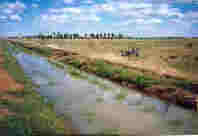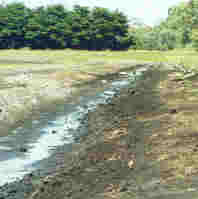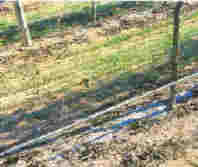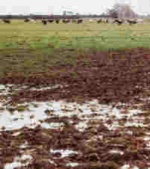 |
|
|
 |
|
|
|
|
| home
water crisis videos droughtproofing in Ethiopia more about water scheduling publications CONTACT WATERRIGHT |
Lessons for AustraliaAustralia has much in common with Ethiopia, particularly water shortage, unreliable rains and periodic droughts. What can we learn from the Ethiopian exercise?Are there lessons for Murray Darling basin rehabilitation? | |||||||||||||||||||||
| |||||||||||||||||||||
|
|
Large channels, flowing continuously transport large amounts of water. There are losses, but as a percentage of total flow they are relatively small. Large pipes are very expensive so the cost of piping these large channels is very high. |

|
Small channels, particularly, those that are only used intermittently during irrigation, are chronically inefficient with very high losses, relative to the water moved.
|

|
This small pipe, costing cents per metre, can
replace these inefficient channels, by running continuously. Micro-flood
with the tilt valve is a very economic solution. |

|
Precise amounts of water can be applied, so advance scheduling techniques can be used to manage the water. Water can be confined to the roots zone, so rising water tables and salinity are not aggravated. There is no need for recycling systems, uniform water distribution and controlled application make these obsolete. |
The beauty of the Ethiopian project is that we were able to look at the total system, e.g.. the combination of water transport, irrigation efficiency scheduling and crop selection with a clean sheet of paper. What a wonderful experience it would be to rethink the Murray Darling Basin starting from scratch without all the historical, social and political baggage that we now carry.
We would be able to select the right crops, the appropriate
irrigation system for those crops, the right delivery system and
an overall harmony with the environment.

|
Banrock Station is an example of a well balanced, environmentally sensitive operation. They are among the best irrigators in the business, using soil and plant monitoring, efficient water management irrigating small amounts each day. They have successfully rehabilitated their winery wetlands. |

|
The land is not just used for production. Wet lands and conservation projects enhance the tourist potential and assist in salinity control. |

|
They do not need an expensive infra structure to deliver water, this can be done by a pipe about the size of a suburban down pipe. It is a well balanced and efficient system overall and is an example for the rest of Australia.
If all irrigators were as efficient as Banrock Station the cost of replacing channel with pipes would be a fraction of the proposed $10 billion. |
Many areas with efficient irrigation are already piped. The two go together. Efficient irrigation means piping cost are acceptable.
Piping raises the cost of water which encourages efficient irrigation.

|
Now consider a typical flood irrigator such
as a dairy farmer with a bay length of 400 meters. This system
is 'leaky' from beginning to end. If water is applied slowly
it wont even reach the end of the paddock. The only way to make it work
is to apply large volumes of water very quickly. Losses still
occur but they are spread over a large volume so the percentage losses
are reduced. Leaky channels and flood irrigation only work by delivering large slugs (or packets) of water at each irrigation. This is the basis of our entire flood irrigation infrastructure. Channels are cheap and effective at delivering these large slugs of water. Many channels only flow for 2% of the time but this is acceptable because they are cheap. Pipes are simply not a cost effective way of delivering these large intermittent slugs of water. At great cost, they solve only one particular aspect of water losses, those in the channel. They do nothing about resolving the losses from evaporation and leakage in the paddocks, which are far greater than the losses in the channels. Large intermittent slugs of water are not just an inefficient way to transport water, but a bad way to irrigate. Our two major flood irrigated crops, cotton and pasture are particularly prone to saturated soils. They simply stop growing until the surplus water has drained or evaporated away. It does not make sense that in a dry country that we reduce our production by saturating the soil, Piping water to feed flood irrigation is only half a solution, it is bad technology and bad economics. Deep cycle scheduling (flood and dry ) has become entrenched because the only way we can get the water to the end of our leaky channels and paddocks is to send down these slugs of water. When we replace channels with pipes, there is no technical reason why we have to continue using these slugs of water. We can select the irrigation schedule which gives us the most productive growth for our crops. |

|
This means maintaining our soils at a more uniform moisture level which in turn means we replace the surges of water with a more steady flow which dramatically cuts the cost of piping. Replacing channels with pipes and changing our irrigation system are totally linked. The best returns will come from a combination of replacing channels by piping, coupled with improving on farm efficiency for flood irrigation.Upgrading should start with farmers who who are prepared to improve their system, encouraged by Government schemes which provide financial assistance. |
Australia shares the same problem as Ethiopia:- periodic droughts.
It was simply not possible to irrigate the entire are under cultivation
under these drought conditions. Instead a small area growing water
and nutrient efficient plants was irrigated effectively .
Similarly in Australia we will not be able to irrigate all areas
during a drought. We can put smaller areas under high efficiency irrigation
to help us survive the bad periods. For example in one of our test
sites in NSW we are irrigating 13 hectares of water efficient lucerne form
a 50 mm pipe. Not ideal irrigation, but a far more effective strategy
than trying to partially flood irrigate low water efficiency pasture.
|
|
moorea web solutions